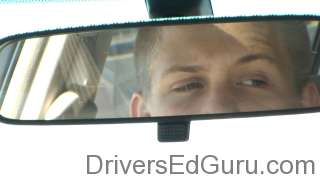Stage 2: Creating a Space Management System – Part 1
Location: Low-traffic neighborhoods and residential streets.
Length of Lesson: 35-45 minutes.
Start with as few distractions as possible
If you’re not sure what a space management is, check out the What is a Space Management System article.
Unfortunately, you can’t develop your teen’s SMS by talking about it. You must have your teen get behind the wheel and start driving. However, try to follow a staged approach in which you ramp up the level of complexity as their skill and comfortability increases.
Just the front

Restrict your lesson to a low-traffic or empty neighborhood and simply drive around. Your teen will have to focus on avoiding on-coming traffic and, depending on the neighborhood you’ve chosen, parked cars on the side of the road. In this exercise, your teen’s main focus is on the front zones. Their job is to successfully maneuver the car through these residential streets. Their needn’t be much focus on the rear zones…yet.
While they’re avoiding oncoming traffic and parked cars, your job is to be on the look-out for everything else. This includes off-road dangers such as kids playing in yards and pets about to run across the road. It also includes on-road dangers that your teen isn’t looking for such as someone about to open the door of their parked car. Your teen simply isn’t ready to process all of this information.
Once they demonstrate their ability to maintain proper lane position despite oncoming traffic and parked cars, you can add more complexity.
Incorporate the mirrors
As soon as you think your teen is ready, start emphasizing use of their mirrors. It is completely impractical, not to mention unsafe, to constantly turn your head away from the road ahead in order to look at the areas directly next to and behind the vehicle. That’s why your car has three mirrors.
We recommend checking your mirrors every 7-10 seconds depending on the roadway conditions. This will not be natural for your teen. You’ll have to constantly remind them to use their mirrors.

Glancing versus Looking
One winter morning I got a call from my wife because her car wouldn’t start. After we determined we couldn’t jump start the car, she called AAA and had the car towed. At the dealer, they gave her a loaner. It was the same make and model, but instead of baby blue, it was bright red. When I got home that night, I parked my car next to hers. I walked behind and alongside it in order to get inside our house.
Once inside, my wife asked me if I liked the color of her “new” car. I had absolutely no idea what color it was. I had glanced at her car, but I hadn’t looked at it.
The difference is oh-so-important when it comes to driving. If you aren’t paying attention to what you’re seeing, glancing at your mirrors is a complete waste of time. You have to ensure that when your teen is looking at their mirrors that they’re processing what they’re seeing. In order to do this, quiz them as they’re driving.
Mirror Quizzing
For example, you may say, “What is the color of the car behind us?” or “Is the car to the left speeding up, slowing down, or staying at the same speed?” These questions force your teen to take a short, but focused look in their mirrors.
We highly recommend having your teen answer these questions without glancing in their mirrors first. This will encourage more frequent looks in the mirror so that they’re not caught off guard by your questions.
When to consult the mirror
Your teen should be looking in their mirrors every 7-10 seconds. However, if they’re about to turn or brake, their mirrors should also be consulted.
- Braking: The rearview mirror should be used whenever braking. You need to be aware if someone is tailgating you. If so, your braking may cause an accident. If a crash ensued, obviously, you would be in the right, but you would also be in a crash. And being right is no consolation for a traffic crash.
- Turning: The mirror should always be used when turning. In fact, they should be consulted twice: once prior to signaling and again before you start the turn.
Part Two
Before moving on to Creating a Space Management System: Part 2, make sure your teen is very comfortable using their mirrors. They should be dominating their mirror quizzes.

